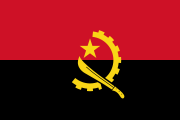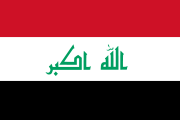AK-47
| AK-47[1] | |
|---|---|
 AK-47 |
|
| Type | Assault rifle |
| Place of origin | |
| Service history | |
| In service | 1949–present |
| Used by | See Users |
| Production history | |
| Designer | Mikhail Kalashnikov |
| Designed | 1944–1946 |
| Manufacturer | Izhmash |
| Number built | approximately 75 million AK-47 100 million AK-type rifles[2][3] |
| Variants | See Variants |
| Specifications | |
| Weight | 4.3 kg (9.5 lb) with empty magazine |
| Length | 870 mm (34.3 in) fixed wooden stock 875 mm (34.4 in) folding stock extended 645 mm (25.4 in) stock folded |
| Barrel length | 415 mm (16.3 in) |
|
|
|
| Cartridge | 7.62x39mm M43 |
| Action | Gas-operated, rotating bolt |
| Rate of fire | 600 rounds/min |
| Muzzle velocity | 715 m/s (2,346 ft/s) |
| Effective range | 300 metres (330 yd) full automatic[4] 400 metres (440 yd) semi-automatic[4] |
| Feed system | 20 or 30-round detachable box magazine, also compatible with 40-round box or 75-round drum magazines from the RPK |
| Sights | Adjustable iron sights, 100–800 metre adjustments, 378 mm (14.9 in) sight radius |
The AK-47 is a selective fire, gas operated 7.62x39mm assault rifle, first developed in the Soviet Union by Mikhail Kalashnikov. The designation AK-47 stands for Kalashnikov automatic rifle, model of 1947 (Russian: Автомат Калашникова 47, tr. Avtomat Kalashnikova 47). It is officially known as Avtomat Kalashnikova (or simply 'AK'). Also it is known as Kalashnikov or Russian jargon Kalash.
Design work on the AK began in 1944. In 1946 a version of the rifle, the AK-46, was presented for official military trials, and a year later the fixed stock version was introduced into service with select units of the Soviet Army. An early development of the design was the AKS-47 (S—Skladnoy or "folding"), which differed in being equipped with an underfolding metal shoulder stock. The AK-47 was officially accepted by the Soviet Armed Forces in 1949 and used by the majority of the member states of the former Warsaw Pact.
The AK-47 fires the 7.62x39mm cartridge which produces significant wounding (including remote wounding effects known as hydrostatic shock) in cases where the projectile tumbles and fragments in tissue,[5] but which produces relatively minor wounds in cases where the projectile exits before beginning to yaw.[6][7]
The original AK-47 was one of the first true assault rifles.[8][9] Even after seven decades, due to its durability, low production cost and ease of use, the model and its variants remain the most widely used and popular assault rifles in the world. It has been manufactured in many countries and has seen service with regular armed forces as well as irregular, revolutionary and terrorist organizations worldwide. The AK-47 was also used as a basis for the development of many other types of individual and crew-served firearms. More AK-type rifles have been produced than all other assault rifles combined.[2]
Contents |
History
Design background
During World War II, the Germans first developed the assault rifle concept, based upon research that showed that most firefights happen at close range, within 300 meters approx. . The power and range of contemporary rifle cartridges was excessive for most small arms firefights. As a result, armies sought a cartridge and rifle combining submachine gun features (large-capacity magazine, selective-fire) with an intermediate-power cartridge effective to 300 meters. To reduce manufacturing costs, the 7.92x57mm Mauser cartridge case was shortened, the result of which was the lighter 7.92x33mm Kurz.
The resultant rifle, the Sturmgewehr 44 (StG44), was not the first with these features; its predecessors were the Italian Cei-Rigotti and the Russian Fedorov Avtomat design rifles. The Germans, however, were the first to produce and field sufficient numbers of this assault rifle to properly evaluate its combat utility. Towards the end of the war, they fielded the weapon against the Soviets; the experience deeply influenced Soviet military doctrine in the post-war years .
Mikhail Kalashnikov began his career as a weapon designer while in a hospital after he was shot in the shoulder during the Battle of Bryansk.[10] After tinkering with a sub-machine gun design, he entered a competition for a new weapon that would chamber the 7.62x41mm cartridge developed by Elisarov and Semin in 1943 (the 7.62x41mm cartridge predated the current 7.62x39mm M1943). A particular requirement of the competition was the reliability of the firearm in the muddy, wet, and frozen conditions of the Soviet frontline. Kalashnikov designed a carbine, strongly influenced by the American M1 Garand, that lost out to the Simonov design that later became the SKS semi-automatic carbine. At the same time, the Soviet Army was interested in developing a true assault rifle employing a shortened M1943 round. The first such weapon was presented by Sudayev in 1944; however in trials it was found to be too heavy.[11] A new design competition was held two years later where Kalashnikov and his design team submitted an entry. It was a gas-operated rifle which had a breech-block mechanism similar to his 1944 carbine, and a curved 30-round magazine.
Kalashnikov's rifles (codenamed AK-1 and -2) proved to be reliable and the gun was accepted to second round of competition along with designs by A.A Demetev and F. Bulkin. In late 1946, as the guns were being tested, one of Kalashnikov's assistants, Aleksandr Zaytsev, suggested a major redesign of AK-1, particularly to improve reliability. At first, Kalashnikov was reluctant, given that their rifle had already fared better than its competitors; however eventually Zaytsev managed to persuade Kalashnikov. The new rifle was produced for a second round of firing tests and field trials. There, Kalashnikov assault rifle model 1947 proved to be simple and reliable, under a wide range of conditions with convenient handling characteristics. In 1949 it was therefore adopted by the Soviet Army as '7.62mm Kalashnikov assault rifle (AK)'.[12]
Design concept
The AK-47 is best described as a hybrid of previous rifle technology innovations: the trigger, double locking lugs and unlocking raceway of the M1 Garand/M1 carbine,[13] the safety mechanism of the John Browning designed Remington Model 8 rifle,[14] and the gas system and layout of the Sturmgewehr 44. Kalashnikov's team had access to all of these weapons and had no need to "reinvent the wheel",[15][16] though he denied that his design was based on the German Sturmgewehr 44 assault rifle.[17] Kalashnikov himself observed: "A lot of [Soviet Army soldiers] ask me how one can become a constructor, and how new weaponry is designed. These are very difficult questions. Each designer seems to have his own paths, his own successes and failures. But one thing is clear: before attempting to create something new, it is vital to have a good appreciation of everything that already exists in this field. I myself have had many experiences confirming this to be so."[18]
Receiver development


There were many difficulties during the initial phase of production. The first production models had stamped sheet metal receivers. Difficulties were encountered in welding the guide and ejector rails, causing high rejection rates.[19] Instead of halting production, a heavy machined receiver was substituted for the sheet metal receiver.[20] This was a more costly process, but the use of machined receivers accelerated production as tooling and labor for the earlier Mosin-Nagant rifle's machined receiver were easily adapted. Partly because of these problems, the Soviets were not able to distribute large numbers of the new rifle to soldiers until 1956. During this time, production of the interim SKS rifle continued.[20]
Once manufacturing difficulties had been overcome, a redesigned version designated the AKM (M for "modernized" or "upgraded"—in Russian: (Автомат Калашникова Модернизированный [Avtomat Kalashnikova Modernizirovanniy]) was introduced in 1959.[21] This new model used a stamped sheet metal receiver and featured a slanted muzzle brake on the end of the barrel to compensate for muzzle rise under recoil. In addition, a hammer retarder was added to prevent the weapon from firing out of battery (without the bolt being fully closed), during rapid or automatic fire.[22] This is also sometimes referred to as a "cyclic rate reducer", or simply "rate reducer", as it also has the effect of reducing the number of rounds fired per minute during automatic fire. It was also roughly one-third lighter than the previous model.[21] Both licensed and unlicensed production of the Kalashnikov weapons abroad were almost exclusively of the AKM variant, partially due to the much easier production of the stamped receiver. This model is the most commonly encountered, having been produced in much greater quantities. All rifles based on the Kalashnikov design are frequently referred to as AK-47s in the West, although this is only correct when applied to rifles based on the original three receiver types.[23] In most former Eastern Bloc countries, the weapon is known simply as the "Kalashnikov". The photo above at right illustrates the differences between the Type 2 milled receiver and the Type 4 stamped, including the use of rivets rather than welds on the stamped receiver, as well as the placement of a small dimple above the magazine well for stabilization of the magazine.
In 1978, the Soviet Union began replacing their AK-47 and AKM rifles with a newer design, the AK-74. This new rifle and cartridge had only started being exported to eastern European nations when the Soviet Union collapsed, drastically slowing production of this and other weapons of the former Soviet bloc.
| Receiver type | Description |
|---|---|
| Type 1A/B | Original stamped receiver for AK-47. -1B modified for underfolding stock. A large hole is present on each side to accommodate the hardware for the underfolding stock.
(this naming convention continues with all types) |
| Type 2A/B | Milled from steel forging. |
| Type 3A/B | "Final" version of the milled receiver, from steel bar stock. The most ubiquitous example of the milled-receiver AK-47. |
| Type 4A/B | Stamped AKM receiver. Overall, the most-used design in the construction of the AK-series rifles. |
Features


The main advantages of the Kalashnikov rifle are its simple design, fairly compact size and adaptation to mass production. It is inexpensive to manufacture, and easy to clean and maintain; its ruggedness and reliability are legendary.[24][25] The AK-47 was initially designed for ease of operation and repair by glove-wearing Soviet soldiers in Arctic conditions. The large gas piston, generous clearances between moving parts, and tapered cartridge case design allow the gun to endure large amounts of foreign matter and fouling without failing to cycle. This reliability comes at the cost of accuracy, as the looser tolerances do not allow for precision and consistency. Reflecting Soviet infantry doctrine of its time, the rifle is meant to be part of massed infantry fire, not long range engagements. The average service life of an AK-47 is 20 to 40 years depending on the conditions to which it has been exposed.[9]
The notched rear tangent iron sight is adjustable, and is calibrated in hundreds of meters. The front sight is a post adjustable for elevation in the field. Windage adjustment is done by the armory before issue. The battle setting places the round within a few centimeters above or below the point of aim out to about 250 meters (275 yd). This "point-blank range" setting allows the shooter to fire the gun at any close target without adjusting the sights. Longer settings are intended for area suppression. These settings mirror the Mosin-Nagant and SKS rifles which the AK-47 replaced. This eased transition and simplified training.
The prototype of the AK-47, the AK-46, had a separate fire selector and safety.[26] These were later combined in the production version to simplify the design. The fire selector acts as a dust cover for the charging handle raceway when placed on safe. This prevents intrusion of dust and other debris into the internal parts. The dust cover on the M16 rifle, in contrast, is not tied to the safety, and has to be manually closed.
The bore and chamber, as well as the gas piston and the interior of the gas cylinder, are generally chromium-plated. This plating dramatically increases the life of these parts by resisting corrosion and wear. This is particularly important, as most military-production ammunition (and virtually all ammunition produced by the Soviet Union and other Communist nations) during the 20th century contained potassium chlorate in the primers. On firing, this was converted to corrosive and hygroscopic potassium chloride which mandated frequent and thorough cleaning in order to prevent damage. Chrome plating of critical parts is now common on many modern military weapons.
The construction of the AK magazine is very robust with reinforced feed lips that contribute to the reliable functioning for which the design is noted. Most Yugoslavian and some East German AK magazines were made with cartridge followers that hold the bolt open when empty; however, most AK magazine followers allow the bolt to close when the magazine is empty.
Operating cycle
To fire, the operator inserts a loaded magazine, moves the selector lever to the lowest position, pulls back and releases the charging handle, aims, and then pulls the trigger. In this setting, the firearm fires only once (semi-automatic), requiring the trigger to be released and depressed again for the next shot. With the selector in the middle position (full-automatic), the rifle continues to fire, automatically cycling fresh rounds into the chamber, until the magazine is exhausted or pressure is released from the trigger. As each bullet travels through the barrel, a portion of the gases expanding behind it is diverted into the gas tube above the barrel, where it impacts the gas piston. The piston, in turn, is driven backward, pushing the bolt carrier, which causes the bolt to move backwards, ejecting the spent round, and chambering a new round when the recoil spring pushes it back.[27]
Disassembly
Dismantling the rifle involves the operator depressing the magazine catch and removing the magazine. The charging handle is pulled to the rear and the operator inspects the chamber to verify the weapon is unloaded. The operator presses forward on the retainer button at the rear of the receiver cover while simultaneously lifting up on the rear of the cover to remove it. The operator then pushes the spring assembly forward and lifts it from its raceway, withdrawing it out of the bolt carrier and to the rear. The operator must then pull the carrier assembly all the way to the rear, lift it, and then pull it away. The operator removes the bolt by pushing it to the rear of the bolt carrier; rotating the bolt so the camming lug clears the raceway on the underside of the bolt carrier and then pulls it forward and free. When cleaning, the operator will pay special attention to the barrel, bolt face, and gas piston, then oil lightly and reassemble.[27]
Ballistics
The standard AK-47 or AKM fires the 7.62x39mm cartridge with a muzzle velocity of 710 metres per second (2,300 ft/s). Muzzle energy is 2,010 joules (1,480 ft·lbf). Projectile weight is normally 8 grams (120 gr). The AK-47 and AKM, with the 7.62×39mm cartridge, have a maximum effective range of around 400 metres (1,300 ft).
Variants
Kalashnikov variants include:
- AK-47 1948–51, 7.62x39mm—The very earliest models, with the Type 1 stamped sheet metal receiver, are now very rare.
- AK-47 1952, 7.62x39mm—Has a milled receiver and wooden buttstock and handguard. Barrel and chamber are chrome plated to resist corrosion. Rifle weight is 4.2 kg (9.3 lb).
- AKS-47—Featured a downward-folding metal stock similar to that of the German MP40, for use in the restricted space in the BMP infantry combat vehicle, as well as by paratroops.
- RPK, 7.62x39mm—Hand-held machine gun version with longer barrel and bipod.
- AKM, 7.62x39mm—A simplified, lighter version of the AK-47; Type 4 receiver is made from stamped and riveted sheet metal (see schematic above). A slanted muzzle device was added to counter climb in automatic fire. Rifle weight is 3.1 kg (6.8 lb) due to the lighter receiver. This is the most ubiquitous variant of the AK-47.
- AKMS, 7.62x39mm—Folding-stock version of the AKM intended for airborne troops. Stock may be either side- or under-folding
- AK-74 series, 5.45x39mm
- AK-101/AK-102 series
- AK-103/AK-104 series
- AK-107/AK-108 series
- AK-200 series
- Saiga semi-automatic rifle – AK variant for hunting and civilian use. Built on AK receiver with hunting style stock and hand guard in 223/5.56, 7.62x39, 5.45x39, 308WIN
- Saiga semi-automatic shotgun – AK variant for hunting and civilian use. Built on AK receiver with hunting style stock and hand guard in 12-Gauge, 20-Gauge, and .410-Bore.
Production outside of the Soviet Union/Russia
Military variants only.
| Country | Variant(s) |
|---|---|
| Albania | |
| Automatiku Shqiptar tipi 1982 (ASH-82) Albanian Automatik Rifle type 1982 (Straight forward copy of Type 56, which in turn is a clone of the Soviet AKM rifle)[28] | |
| Tip C (Type C) Sniper Rifle | |
| Bulgaria | AKK (Type 3 AK-47), AKKS (Type 3 with side-folding buttstock) |
| AKKMS (AKMS) AKKN-47 (fittings for NPSU night sights) | |
| AK-47M1 (Type 3 with black polymer furniture) | |
| AK-47MA1/AR-M1 (same as -M1, but in 5.56 mm NATO) | |
| AKS-47M1 (AKMS in 5.56x45mm NATO), AKS-47MA1 (same as AKS-47M1, but semi-automatic only) | |
| AKS-47S (AK-47M1, short version, with East German folding stock, laser aiming device) | |
| AKS-47UF (short version of -M1, Russian folding stock), AR-SF (same as -47UF, but 5.56 mm NATO) | |
| AKS-93SM6 (similar to -47M1, cannot use grenade launcher) | |
| RKKS, AKT-47 (.22 rimfire training rifle) | |
| People's Republic of China | Type 56 |
| German Democratic Republic | MPi-K (AK-47), MPi-KS (AKS), MPi-KM (AKM), MPi-KMS-72 (AKMS), KK-MPi Mod.69 (.22-Lr select-fire trainer); |
| Egypt | AK-47, Misr assault rifle (AKM), Maadi |
| Ethiopia | AK-47, AK-103 |
| Hungary | AK-63D/E (AMM/AMMSz), AKM-63, AMD-65, AMD-65M, AMP, NGM 5.56 |
| Iraq | Tabuk Sniper Rifle, Tabuk Assault Rifle (AKM/AKMS), Tabuk Short Assault Rifle |
| India | AK-47 |
| Iran | KLS (AK-47), KLF (AKS), KLT (AKMS) |
| Israel | IMI Galil |
| Finland | RK 62, RK 95 TP |
| Nigeria | OBJ-006[29] |
| North Korea | Type 58A (Type 3 AK-47), Type 58B (stamped steel folding stock), Type 68A (AKM-47) Type 68B (AKMS)[30][31] |
| Pakistan | Reverse engineered by hand and machine in Pakistan's highland areas near the border of Afghanistan. |
| Poland | pmK/kbk AK (name has changed from pmK – "pistolet maszynowy Kałasznikowa", Kalashnikov SMG to the kbk AK – "karabinek AK", Kalashnikov Carbine in mid 1960s) (AK-47), kbkg wz. 1960, kbk AKM (AKM), kbk AKMS (AKMS), kbk wz. 1988 Tantal based on the 7.62 mm kbk AKMS wz. 81, kbs wz. 1996 Beryl |
| Romania | PM md. 63 (AKM), PM md. 65 (AKMS), PM md. 90 (AKMS), collectively exported under the umbrella name AIM or AIMS |
| PA md. 86 (AK-74), exported as the AIMS-74 | |
| PM md. 90 short barrel (AK-104), PA md. 86 short barrel (AK-105) exported as the AIMR | |
| Serbia | Zastava M70, M76, M77, M92, M21 |
| South Africa | R4 assault rifle |
| Sudan | MAZ,[32] based on the Type 56 |
| Vietnam | Chinese Type 56 |
| Venezuela | License granted, factory under construction[33] |
| Former Yugoslavia | M60, M64 (AK-47 with longer barrel), M64A (grenade launcher), M64B (M64 w/ folding stock), M66, M70, M70A, M70B1, M70AB2, |
Certainly more have been produced elsewhere; but the above list represents known producers and is limited to only military variants. An updated AKM design is still produced in Russia.
Derivatives

The basic design of the AK-47 has been used as the basis for other successful rifle designs such as the Finnish Rk 62/76 and Rk 95 TP, the Israeli Galil, the Indian INSAS and the Yugoslav Zastava M76 and M77/82 rifles. Several bullpup designs have surfaced such as the Chinese Norinco Type 86S, although none have been produced in quantity. Bullpup conversions are also available commercially.
Licensing
Russia has repeatedly claimed that the majority of manufacturers produce AK-47s without a proper license from IZH.[34][35] The Izhevsk Machine Tool Factory acquired a patent in 1999, making manufacture of the Kalashnikov rifle system by anyone other than themselves illegal.[23] However, nearly one million AK-47 assault rifles are manufactured without a license each year.[10]
Illicit trade

Throughout the world, the AK and its variants are among the most commonly smuggled small arms sold to governments, rebels, criminals, and civilians alike, with little international oversight. In some countries, prices for AKs are very low; in Somalia, Rwanda, Mozambique, Congo and Ethiopia, prices are between $30 and $125 per weapon, and prices have fallen in the last few decades due to mass counterfeiting. Moisés Naím observed that in a small town in Kenya in 1986, an AK-47 cost fifteen cows but that in 2005, the price was down to four cows indicating that supply was "immense".[36] The weapon has appeared in a number of conflicts including clashes in the Balkans, Iraq, Afghanistan, and Somalia.[37]
After the Soviet retreat from Afghanistan, the Soviet Army left quantities of weapons including AKs which were subsequently used in the civil war between the Taliban and the Northern Alliance and were also exported to Pakistan. The gun is now also made in Pakistan's semi-autonomous areas (see more at Khyber Pass Copy). It is widely used by tribes in Africa like the Hamer, amongst others.
The World Bank estimates that out of the 500 million total firearms available worldwide, 100 million are of the Kalashnikov family, and 75 million of which are AK-47s.[38] Mikhail Kalashnikov addressed the United Nations in 2006 at a conference aimed at solving the problem of illicit weapons, saying that he appreciated the AK-47's role in state-sponsored defense but that counterfeit weapons carrying his name in the hands of "terrorists and thugs" caused him regret.[39]
Cultural influence
The Soviet Union and the People's Republic of China as well as the Western countries (especially the United States) supplied arms and technical knowledge to numerous countries and rebel forces in a global struggle between the Warsaw Pact nations and their allies against NATO and their allies called the Cold War. While the NATO countries used rifles such as the relatively expensive M14, FN FAL, and H&K G3 battle rifles and M16 assault rifle during this time, the low production and materials costs of the AK-47 meant that the Soviet Union could produce and supply its allies at a very low cost. Because of its low cost, it was also duplicated or used as the basis for many other rifles, such as the Israeli Galil, Chinese Type 56, and Swiss SIG SG 550. As a result, the Cold War saw the mass export, of AK-47s by the Soviet Union and the PRC to their allies, such as the Nicaraguan Sandinistas, Viet Cong as well as Middle Eastern, Asian, and African revolutionaries. The United States also purchased the Type 56 from the PRC to give to the mujahideen guerrillas during the Soviet war in Afghanistan.[40]
The proliferation of this weapon is reflected by more than just numbers. The AK is included in the flag of Mozambique and its coat of arms, an acknowledgment that the country's leaders gained power in large part through the effective use of their AK-47s.[41] It is also found in the coat of arms of Zimbabwe and East Timor, the revolution era coat of arms of Burkina Faso, the flag of Hezbollah, and the logo of the Iranian Islamic Revolutionary Guards Corps.
In parts of the Western world, the AK-47 is associated with their enemies, both Cold War era and present-day. During the 1980s, the Soviet Union became the principal arms dealer to countries embargoed by Western democracies, including Middle Eastern nations such as Syria, Libya and Iran, who welcomed Soviet Union backing against Israel. After the fall of the Soviet Union, AK-47s were sold both openly and on the black market to any group with cash, including drug cartels and dictatorial states, and more recently they have been seen in the hands of violent Islamic terrorist groups such as the Taliban and Al-Qaeda in Afghanistan and Iraq, and FARC guerrillas in Colombia. Movies often portray criminals, gang members and terrorists using AK-47s. For these reasons, the AK-47 is stereotypically regarded as the weapon of choice of insurgents, terrorists, gangsters and dictatorships.
In Mexico, the AK-47 is known as "Cuerno de Chivo" (literally "Ram's Horn") and is one of the weapons of choice of Mexican drug cartels. It is sometimes mentioned in Mexican folk music lyrics.
In 2006, Colombian musician and peace activist César López devised the escopetarra, an AK converted into a guitar. One sold for US$17,000 in a fundraiser held to benefit the victims of anti-personnel mines, while another was exhibited at the United Nations' Conference on Disarmament.[42]
Kalashnikov Museum
The Kalashnikov Museum (also called the AK-47 museum) opened on November 4, 2004, in Izhevsk, a city in the Ural Mountains of Russia. The museum chronicles the biography of General Kalashnikov, as well as documents the invention of the AK-47. The museum complex of small arms of M. T. Kalashnikov, a series of halls and multimedia exhibitions is devoted to the evolution of the AK-47 assault rifle and attracts 10,000 monthly visitors. The museum serves as Russia's monument to this world-renowned infantry weapon.
It presents the guns and their history with civic pride and a revived sense of national confidence. Think of Izhesvk as the Detroit of Slavic small arms. The exhibitions, ranging from static displays of weapons to plasma-screen video presentations showing the guns' use in recent decades, reflect a laborer's affection for what has long flowed from nearby foundries and assembly lines. Much of the material is also viewed through the life of Gen. Mikhail T. Kalashnikov, the man credited with designing the weapon in secret trials in 1947, and who still lives a few blocks away.[43]
Nadezhda Vechtomova, the museum director stated in an interview that the purpose of the museum is to honor the ingenuity of the inventor and the hard work of the employees and to "separate the weapon as a weapon of murder from the people who are producing it and to tell its history in our country."
Users

 Afghanistan[44]
Afghanistan[44] Albania[45]
Albania[45] Algeria[45]
Algeria[45] Angola[45]
Angola[45] Armenia[45]
Armenia[45] Bangladesh[45]
Bangladesh[45] Benin[45]
Benin[45] Botswana[45]
Botswana[45] Bulgaria[45]
Bulgaria[45] Cambodia[45]
Cambodia[45] Cape Verde[45]
Cape Verde[45] Central African Republic[45]
Central African Republic[45] Chad[45]
Chad[45] Chechnya[45]
Chechnya[45] Comoros[45]
Comoros[45] Congo-Brazzaville[45]
Congo-Brazzaville[45] Cuba[45]
Cuba[45] Democratic Republic of the Congo[45]
Democratic Republic of the Congo[45] Egypt[45]
Egypt[45] Namibia[45]
Namibia[45] East Germany[46]
East Germany[46] Equatorial Guinea[45]
Equatorial Guinea[45] Ethiopia: Type 56 variant.[45]
Ethiopia: Type 56 variant.[45] Gabon[45]
Gabon[45] Georgia[45]
Georgia[45] Greece: EKAM counter-terrorist unit of the Hellenic Police.[47][48]
Greece: EKAM counter-terrorist unit of the Hellenic Police.[47][48] Guinea[45]
Guinea[45] Guinea-Bissau[45]
Guinea-Bissau[45] Guyana[45]
Guyana[45] Hungary[45]
Hungary[45] India: In use by Force One.[49]
India: In use by Force One.[49] Indonesia[50]
Indonesia[50] Iran[45]
Iran[45] Iraq[44][45]
Iraq[44][45] Israel[45]
Israel[45] Laos[45]
Laos[45] Lesotho[45]
Lesotho[45] Liberia[45]
Liberia[45] Libya[45]
Libya[45] Madagascar[45]
Madagascar[45] Mali[45]
Mali[45] Malta: Type 56 variant.[45]
Malta: Type 56 variant.[45] Morocco[45]
Morocco[45] Mongolia[45]
Mongolia[45] Mozambique[45]
Mozambique[45] North Korea: Type 56 and Type 58 variants were used.[45]
North Korea: Type 56 and Type 58 variants were used.[45] People's Republic of China: Type 56 variant was used.[51]
People's Republic of China: Type 56 variant was used.[51] Peru[45]
Peru[45] Philippines: Used by the Santiago City PNP.[52]
Philippines: Used by the Santiago City PNP.[52] Poland[46]
Poland[46] Qatar[45]
Qatar[45] Romania[45]
Romania[45] Sao Tome and Principe[45]
Sao Tome and Principe[45] Seychelles[45]
Seychelles[45] Sierra Leone[45]
Sierra Leone[45] Somalia[45]
Somalia[45] Soviet Union: Adopted by the Soviet Union in 1951.[51]
Soviet Union: Adopted by the Soviet Union in 1951.[51] Sri Lanka: Type 56 variant.[45]
Sri Lanka: Type 56 variant.[45] Sudan[45]
Sudan[45] Syria[45]
Syria[45] Tanzania[45]
Tanzania[45] Togo[45]
Togo[45] Turkey[45]
Turkey[45] Vietnam: Type 56 variant was used extensively by the Viet Cong.[51]
Vietnam: Type 56 variant was used extensively by the Viet Cong.[51] Yemen[45]
Yemen[45] Yugoslavia[46]
Yugoslavia[46] Zambia[45]
Zambia[45] Zimbabwe[45]
Zimbabwe[45]
See also
- Comparison of the AK-47 and M16
- Legal status of the AK-47
- List of Russian weaponry
- List of weapons influenced by the Kalashnikov design
Notes
- ↑ Table data are for AK-47 with Type 2/3 receiver
- ↑ 2.0 2.1 Worldbank.org
- ↑ "AK-47 Inventor Doesn't Lose Sleep Over Havoc Wrought With His Invention". Foxnews.com. 2007-07-06. http://www.foxnews.com/story/0,2933,288456,00.html. Retrieved 2010-04-03.
- ↑ 4.0 4.1 Bidwell, Shelford. The Encyclopedia of land warfare in the 20th century, p. 199. Spring Books, 1977.
- ↑ Bellamy RF, Zajtchuk R. The physics and biophysics of wound ballistics. In: Zajtchuk R, ed. Textbook of Military Medicine, Part I: Warfare, Weaponry, and the Casualty, Vol. 5, Conventional Warfare: Ballistic, Blast, and Burn Injuries. Washington, DC: Office of the Surgeon General, Department of the Army, United States of America (1990) pp. 146–155
- ↑ U.S. Military Small Arms Ammunition Failures and Solutions, GK Roberts, NDIA Dallas, Texas, 21 May 2008, DTIC.mil
- ↑ Wounding Effects of the AK-47 Rifle Used by Patrick Purdy in the Stockton, California, Schoolyard Shooting of January 17, 1989, Fackler, Martin L. M.D.; Malinowski, John A. B.S.; Hoxie, Stephen W. B.S.; Jason, Alexander B.A., American Journal of Forensic Medicine and Pathology, September 1990
- ↑ Poyer, Joe. The AK-47 and AK-74 Kalashnikov Rifles and Their Variations. North Cape Publications. 2004.
- ↑ 9.0 9.1 "Weaponomics: The Economics of Small Arms". http://www.csae.ox.ac.uk/workingpapers/pdfs/2006-13text.pdf.
- ↑ 10.0 10.1 "AK-47 Inventor Doesn't Lose Sleep Over Havoc Wrought With His Invention". Foxnews.com. 2007-07-06. http://www.foxnews.com/story/0,2933,288456,00.html. Retrieved 2009-06-26.
- ↑ Bolotin, D.N, "Soviet Small-Arms and Ammunition", pp 68.
- ↑ Bolotin, pp 69–71.
- ↑ J.F.S. (July 1983). "IMI Galil". Soldier of Fortune (AK-47.net). http://www.ak-47.net/ak47/galil.html. Retrieved 2008-10-19.
- ↑ "Firearm Model History - Remington Model 8". Remington.com. http://www.remington.com/library/history/firearm_models/centerfire/model_8.asp. Retrieved 2008-10-19.
- ↑ "AK-47 Inventor Says Conscience Is Clear, Mikhail Kalashnikov Blames Politicians For Millions Of Deaths Involving His Assault Rifle". CBS News. July 6, 2007. http://www.cbsnews.com/stories/2007/07/06/world/main3025193.shtml?source=RSSattr=World_3025193. Retrieved 2008-10-19.
- ↑ Ezell, Edward Clinton (1986). The AK-47 Story: Evolution of the Kalashnikov Weapons. Mechanicsburg, PA: Stackpole Books. ISBN 0-8117-0916-7.
- ↑ Val Shilin; Charlie Cutshaw. "Mikhail Kalashnikov". Power Custom. http://www.powercustom.com/AKPages/MikhailKalashnikov.htm. Retrieved 2008-10-19.
- ↑ Bolotin, pp 64.
- ↑ Poyer, 8
- ↑ 20.0 20.1 Poyer, 9
- ↑ 21.0 21.1 Ezell, 36
- ↑ Poyer, 11
- ↑ 23.0 23.1 Poyer, 2
- ↑ "An AK for Every Market by James Dunnigan April 23, 2003". Web.archive.org. Archived from the original on 2007-03-25. http://web.archive.org/web/20070325171640/http://www.strategypage.com/dls/articles/20030423.asp. Retrieved 2009-06-26.
- ↑ Rivas, Oswaldo. "Soldiers from special force unit "COE" take part in a military training exercise at the military base, near Managua". Reuters. http://blogs.reuters.com/oddly-enough/2007/06/14/mimes-fighting-to-be-heard/. Retrieved 2008-12-09.
- ↑ Popeneker, Maxim and Williams, Anthony. Assault Rifle The Crowood Press Ltd. (2005) ISBN 1-86126-700-2.
- ↑ 27.0 27.1 Department of the Army. Operators Manual for AK-47 Assault Rifle. 203d Military Intelligence Battalion
- ↑ "Medialb.com". Medialb.com. http://www.medialb.com/forumi/detaje.asp?forumi=22&kat=7&faqja=2&tema=4626. Retrieved 2009-06-26.
- ↑ Nigeria to mass-produce Nigerian version of AK-47 rifles. Retrieved on October 5, 2008.
- ↑ US Department of Defense, North Korea Country Handbook 1997, Appendix A: Equipment Recognition, PPSH 1943 SUBMACHINEGUN (TYPE-50 CHINA/MODEL-49 DPRK), p. A-79.
- ↑ US Department of Defense, North Korea Country Handbook 1997, Appendix A: Equipment Recognition, TYPE-68 (AKM) ASSAULT RIFLE, p. A-77.
- ↑ "MAZ". Military Industry Corporation. http://mic.sd/images/products/wepons/en/MAZbn.html. Retrieved 2009-02-08.
- ↑ Martin Sieff (August 15, 2007). "Defense Focus: Venezuela's Kalashnikovs". UPI.com. http://www.upi.com/International_Security/Industry/Analysis/2007/08/15/defense_focus_venezuelas_kalashnikovs/1273/. Retrieved 2008-10-19.
- ↑ "Восточная Европа захватила рынок продаж автоматов Калашникова". Lenta.ru. http://www.lenta.ru/news/2006/06/13/rifles/. Retrieved 2006-07-19.
- ↑ "'Ижмаш' подсчитал контрафактные автоматы Калашникова". Lenta.ru. http://lenta.ru/news/2006/04/15/fake. Retrieved 2006-07-19.
- ↑ "Carnegie Council. ''ILLICIT: How Smugglers, Traffickers, and Copycats Are Hijacking the Global Economy''. Moisés Naím, Joanne J. Myers. November 9, 2005". Cceia.org. 2005-11-09. http://www.cceia.org/resources/transcripts/5279.html. Retrieved 2009-06-26.
- ↑ "The AK-47: The World's Favourite Killing Machine." ControlArms Briefing Note. Internet, available from Controlarms.org, accessed 11/02/2008.
- ↑ "Worldbank. Post-Conflict Transitions Working Paper No. 10. ''Weaponomics: The Global Market for Assault Rifles''. Phillip Killicoat, Economics, Oxford University. April 2007" (PDF). http://www-wds.worldbank.org/servlet/WDSContentServer/WDSP/IB/2007/04/13/000016406_20070413145045/Rendered/PDF/wps4202.pdf. Retrieved 2010-04-03.
- ↑ "United Nations. ''United Nations Conference to Review Progress Made in the Implementation of the Programme of Action to Prevent, Combat and Eradicate the Illicit Trade in Small Arms and Light Weapons in All Its Aspects.'' New York, 26 June – 7 July 2006" (PDF). http://www.un.org/events/smallarms2006/pdf/rc.6-e.pdf. Retrieved 2010-04-03.
- ↑ "Chinese Type-56 Assault Rifle" 5th Battalion Royal Australian Regiment Association website
- ↑ Michael R. Gordon, "Burst of Pride for a Staccato Executioner: AK-47" The New York Times, March 13, 1997.
- ↑ Latorre, Héctor (2006-01-24). "Escopetarras: disparando música". BBC World. http://news.bbc.co.uk/hi/spanish/misc/newsid_4644000/4644028.stm. Retrieved 2007-01-31.
- ↑ Chivers, C.J. http://travel.nytimes.com/2007/02/18/travel/18heads.html The New York Times 2007-2-18
- ↑ 44.0 44.1 Kahaner, Larry (2006-11-26). "Weapon Of Mass Destruction". Washingtonpost.com. http://www.washingtonpost.com/wp-dyn/content/article/2006/11/24/AR2006112400788.html. Retrieved 2010-04-03.
- ↑ 45.00 45.01 45.02 45.03 45.04 45.05 45.06 45.07 45.08 45.09 45.10 45.11 45.12 45.13 45.14 45.15 45.16 45.17 45.18 45.19 45.20 45.21 45.22 45.23 45.24 45.25 45.26 45.27 45.28 45.29 45.30 45.31 45.32 45.33 45.34 45.35 45.36 45.37 45.38 45.39 45.40 45.41 45.42 45.43 45.44 45.45 45.46 45.47 45.48 45.49 45.50 45.51 45.52 45.53 45.54 45.55 45.56 Jones, Richard D. Jane's Infantry Weapons 2009/2010. Jane's Information Group; 35 edition (January 27, 2009). ISBN 978-0710628695.
- ↑ 46.0 46.1 46.2 http://world.guns.ru/assault/as01-e.htm
- ↑ Milosevic, Milan (2005). "Trojanski Konj za Teroriste" (in Serbian). Kalibar. http://www.kalibar.rs/code/navigate.php?Id=74. Retrieved 2009-04-04.
- ↑ "Greece Ministry of Public Order Press Office: Special Anti-Terrorist Unit". http://astynomia.gr – Official Website of the Hellenic Police. July 2004. http://www.astynomia.gr/images/stories/DOCS/Attachment11480_ENHMEROTIKO_EKAM_ENGL.pdf. Retrieved 2009-09-27.
- ↑ "Maha's elite counter terror unit Force One becomes operational". Business Standard. http://www.business-standard.com/india/news/maha%5Cs-elite-counter-terror-unit-force-one-becomes-operational/377563/. Retrieved 2010-07-05.
- ↑ Indonesian Army official site
- ↑ 51.0 51.1 51.2 Miller, David (2001). The Illustrated Directory of 20th Century Guns. Salamander Books Ltd. ISBN 1-84065-245-4.
- ↑ "Santiago city forms SWAT team to combat crime". Philippine Information Agency. 2006-09-02. http://www.pia.gov.ph/?m=12&sec=reader&rp=1&fi=p060902.htm&no=3&date=09/02/2006. Retrieved 2010-02-01.
References
- Cutshaw, Charlie; Shilin, Valery. Legends and Reality of the AK: A Behind-the-Scenes Look at the History, Design, and Impact of the Kalashnikov Family of Weapons. Boulder, CO: Paladin Press, 2000 (paperback, ISBN 1-58160-069-0).
- Ezell, Edward Clinton (1986). The AK-47 Story: Evolution of the Kalashnikov Weapons. Mechanicsburg, PA: Stackpole Books. ISBN 0-8117-0916-7. Before his death, Ezell was the curator of military history at the Smithsonian Museum
- Ezell, Edward Clinton; R. Blake Stevens (2001). Kalashnikov: The Arms and the Man. Cobourg, ON: Collector Grade Publications. ISBN 0-88935-267-4.
- managing editor, Claire Folkard. (2005). Guinness World Records 2005. London: Guinness World Records. ISBN 1-892051-22-2.
- Hodges, Michael. AK47: the Story of the People's Gun. London: Sceptre, 2007 (hardcover, ISBN 0340921048).
- Kahaner, Larry. AK-47: The Weapon that Changed the Face of War. Hoboken, NJ: Wiley, 2006 (hardcover, ISBN 0-471-72641-9).
- Kalashnikov, Mikhail. The Gun that Changed the World. Cambridge: Polity Press, 2006 (hardcover, ISBN 0-7456-3691-8; paperback, ISBN 0-7456-3692-6).
- Poyer, Joe (2004). The AK-47 and AK-74 Kalashnikov Rifles and Their Variations (Paperback). Tustin, CA: North Cape Publications. ISBN 1-882391-33-0.
- Edward Clinton Ezell; with research assistance of Thomas M. Pegg. (1983). Small Arms of the World. New York: Barnes & Nobles. ISBN 0-88029-601-1.
- Walter, John. Kalashnikov (Greenhill Military Manuals). London: Greenhill Books, 1999 (Hardcover, ISBN 1-85367-364-1).
External links
- Manufacturer's Official Site
- AK Site – Kalashnikov Home Page
- Nazarian's Gun's Recognition Guide (MANUAL) AK 47 Manual (.pdf)
- US Army Operator's Manual for the AK-47 Assault Rifle
- AK-47 Full Auto, U.S. Army in Iraq (video) from Internet Archive
- The Timeless, Ubiquitous AK-47 – slideshow by Time magazine
Video
|
|||||||||||
